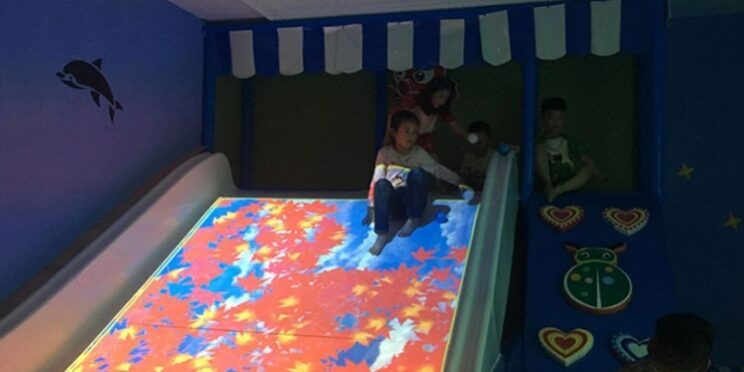What is POE LiDAR?
POE LiDAR (Power Over Ethernet Light Detection and Ranging) is an advanced sensing technology that uses laser pulses to measure distances and create detailed 3D maps of environments. With seamless integration into interactive systems, POE LiDAR offers unparalleled precision, speed, and versatility for various applications, including interactive projection slides.
Unlike traditional touch-based interfaces, POE LiDAR enables non-contact, gesture-based interactions, making it ideal for large-scale, immersive installations.

What are Interactive Projection Slides?
Interactive projection slides are dynamic, touchless displays that transform ordinary surfaces into engaging, interactive experiences. Users can control or navigate the projection by performing gestures like swiping, pulling, or tapping in the air. These systems are commonly used in museums, retail stores, educational institutions, and event venues to create memorable and immersive environments.
How Does POE LiDAR Transform Interactive Projection Slides?
1. Touchless Interaction
With LiDAR sensors, users can interact with the projection without physically touching any surface. Gestures like swiping, pulling, and tapping are detected in real time, ensuring hygienic, seamless interactions—a feature especially valuable in today’s contact-conscious world.
2. Support for Multi-Touch Points
POE LiDAR systems can support up to 255 simultaneous touch points, far surpassing the limitations of traditional touchscreens. This capability allows multiple users to interact simultaneously, even in environments with varying light conditions.
3. Large-Scale Applications
With an interaction radius of up to 70 meters, LiDAR-powered projection slides can be scaled to fit any space, from small meeting rooms to massive exhibition halls. This makes it suitable for large venues like conference centers, museums, and shopping malls.
4. Adapts to Irregular Surfaces
POE LiDAR’s adaptability allows it to function on uneven surfaces such as curved walls, floors, or inclined tables. This flexibility enables innovative applications across diverse environments.
5. High Frame Rate for Smooth Interaction
POE LiDAR systems, such as the F1 model, operate at up to 30 frames per second (FPS), ensuring rapid detection and smooth, precise interaction. This high responsiveness is critical for creating immersive experiences in interactive games, presentations, and educational setups.
6. Easy Integration with Software
By integrating with third-party software, POE LiDAR sensors like Hokuyo’s UST-10LX, -20LX, and -30LX models can provide universal gesture-based screen controls. This compatibility allows the system to work seamlessly with existing displays and applications, offering endless customization possibilities.
Applications of POE LiDAR in Interactive Projection Slides
- Retail: Create interactive product displays that engage customers.
- Museums: Offer educational content through interactive exhibits.
- Restaurants & Hotels: Enhance guest experiences with interactive menus and entertainment.
- Event Spaces: Add wow-factor with interactive installations.
- Educational Institutions: Make learning fun with touchless, interactive teaching aids.
Conclusion
POE LiDAR technology is reshaping the way we experience interactive projection slides. By enabling touchless, multi-user, and large-scale interactions, it offers a more intuitive, flexible, and immersive experience than traditional touchscreens. Its ability to adapt to irregular surfaces and high frame rate detection ensures flawless performance in any environment.
From museums to retail and education, the possibilities with POE LiDAR-powered interactive projection slides are endless. This technology opens up new opportunities for businesses and organizations looking to deliver innovative, engaging experiences.
Embrace the future of interactivity with POE LiDAR technology today!







